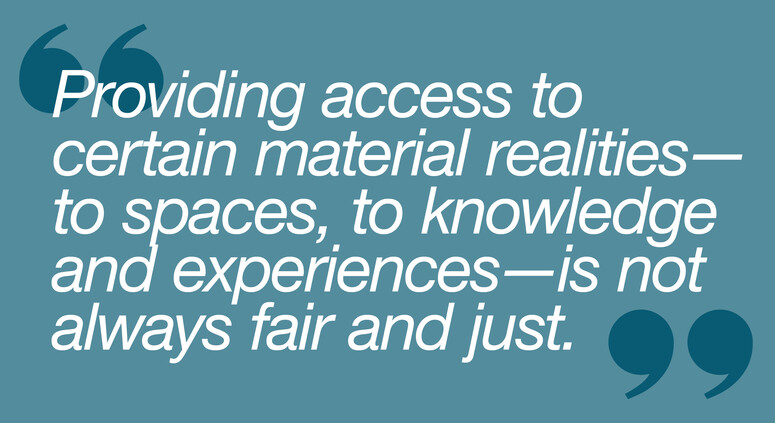snapshot of current issues in design for sustainability
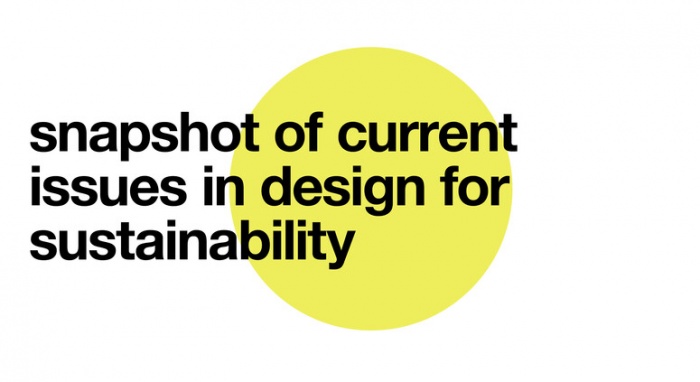
13.05.2021 Editorial
The sustainability of a design is a variable that is very difficult to isolate for, and therefore, equally hard to solve. This is why sustainability is often characterised as a "wicked problem", a term coined by design theorist Horst Rittel, and described as a “class of social system problems which are ill-formulated, where the information is confusing, where there are many clients and decision makers with conflicting values, and where the ramifications in the whole system are thoroughly confusing”. These problems were deemed ‘wicked’ because of the complexity of addressing a system where frictions are passed along in unexpected ways, yielding 'solutions' that can turn out to be worse globally than before the problem was 'solved'.
Practically, what this has meant that well-intentioned designers trying to reduce their negative impacts on the planet have had to undergo a lot of trial and error, especially error. But as science advances, more is known about the interconnected flows involved in the overall lifecycle of designs, and better materials are developed; consumers are also better educated and legislation around lifecycle processes are more transparent. As such, designers are increasingly getting the tools and information needed to have a more sustainable practice.
Here, we collect a current snapshot of article and reports charting the problems of production, consumption and the impact on the climate, as well as some of the recent developments in policy, product design as designers move towards a more circular economy.
GLOBAL WASTE
The problem of plastics
The World Economic Forum-backed initiative Global Plastic Action Partnership (GPAP) estimates that 8 million tonnes of plastic waste leaks into the ocean each year and that by 2050 there will be more plastic than fish in the ocean. Its recent Annual Impact Report 2020 stresses the urgent need for collective action worldwide to create meaningful and sustainable change. Disposal issues, human dependence on single-use plastic and post-pandemic waste management pose challenges worldwide. Indonesia, where business, government and civil society worked with GPAP to develop a plan to reduce the amount of plastic reaching the ocean by 70% within five years is meeting this challenge head-on.
GPAP and the New Plastics Economy initiative call for the elimination of all unnecessary plastics and further innovation to ensure those which are used are reusable, recyclable or compostable. They ask, "How could designers play a role here? A circular economy – in which items are used, not used up – for plastic would keep the material in the wider economy and out of the environment."
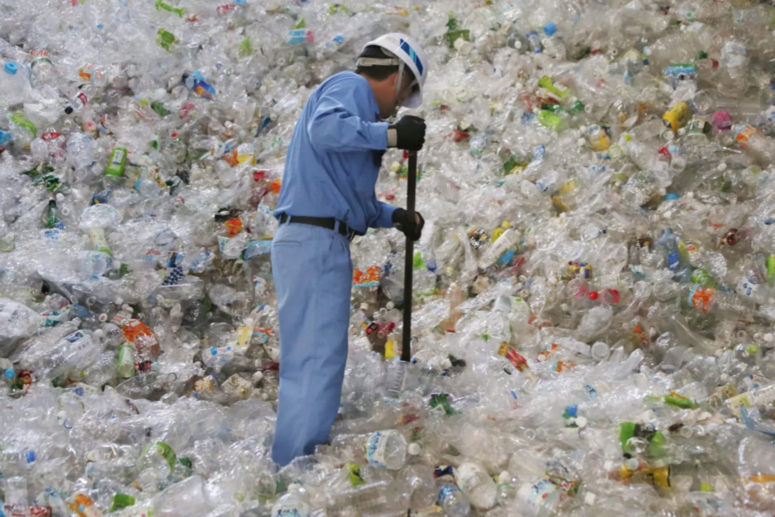
Photo credit: Koji Sasahara/The Associated Press (from article: Coca-Cola, PepsiCo, Nestlé named top plastic polluters in global audit of plastic waste. CBC Technology & Science. 01 December 2020)
An audit on single-use plastics shows that top brands sold at Costco (namely: Coca-Cola, PepsiCo, and Nestlé) are the worst production offenders. Volunteers collected plastic waste on city streets, parks, forests, beaches, coastal areas and other sites where plastic waste accumulates noting that, due the COVID-19 pandemic, about 13% of the items examined came from waste discarded indoors—in homes, offices, schools and elsewhere.
The Global E-Waste Monitor
• The Global E-Waste Monitor 2020
A collaborative product of the Global E-waste Statistics Partnership (GESP), formed by UN University (UNU), the International Telecommunication Union (ITU), and the International Solid Waste Association (ISWA), in close collaboration with the UN Environment Programme (UNEP), the E-Waste Monitor offers useful information, statistics and a global report on the state of electronic waste in 2020.
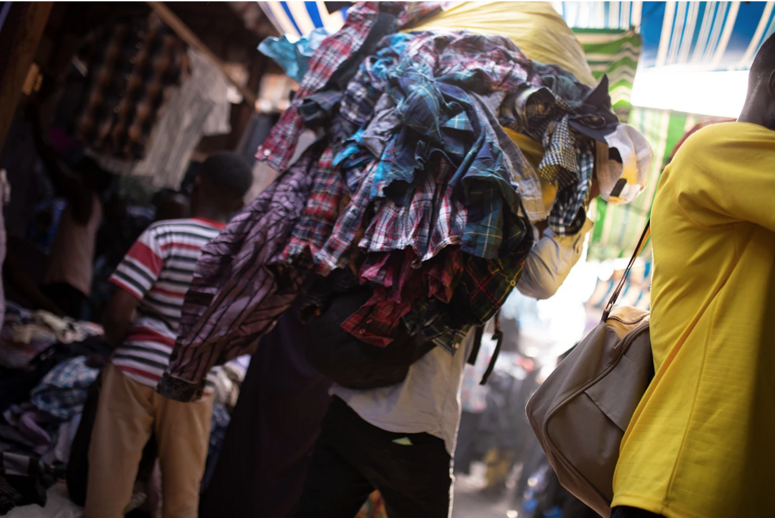
Image credit: The OR Foundation / Nana Kwadwo Agyei Addo. From the article: This Is What Actually Happens to Your Donated Clothes. Highsnobiety. 21 April 2021.
Donating is not circular
The fast fashion industry is widely known to be decidedly un-environmental. From the chemical impacts of fibre production, to the model of rapid consumption and waste, fashion needs to change. This article calls out the specific impacts of the process of 'donating' clothes and how this moves the problem from the global north to the global south but does not solve any of the underlying issues.
A CALL FOR THE CIRCULAR ECONOMY
Ellen MacArthur Foundation and the Circular Economy
The Ellen MacArthur Foundation has published a paper on circular design highlighting the irreversible costs of design: “Design decisions often lead to long-term investments that lock us into a certain model for years to come […] and we can’t unscramble an omelette.” Because, "over 70% of a product’s life-cycle costs and environmental footprint is determined during its design phase" it is fundamental that designers begin to adhere to Circular Economy principles in their practice. Circular design might offer a path for designers to lean towards more regenerative and resilient futures. While there is no perfect solution, a list of questions prompts a series of strategies to follow, outlined in a circular design 'tool kit' and 'design guide' for this necessary journey to design for the circular economy.
Circular Fashion
With the Paris Agreement on Climate Change and Sustainable Development Goals (SDGs) demanding innovative solutions on a global scale to potentially halt climate change and restore biodiversity within specified timeframes, it is crucial that the fashion industry moves away from its linear ‘take, make, waste’ model to a circular one, where materials are perpetually recycled. Driven by data cited in the article and the potential to deliver textile recycling at scale, the Finnish biotechnology group Infinited Fiber Company have led a successful bid for over €6M of European Union research and innovation funding, to form a consortium to create a circular fashion industry blueprint. The funding is geared towards supporting the New Cotton Project’s consortium members, to work together across waste management, recycling, retail, manufacturing and academia to define a new circular fashion system and business model that they hope will lead to industry-wide adoption—and a significant reduction in fashion’s waste and environmental impact.
Implementing Circular Economy notions in design practice
• Dokter, Giliam, Liane Thuvander and Ulrike Rahe. How circular is current design practice? Investigating perspectives across industrial design and architecture in the transition towards a circular economy. Sustainable Production and Consumption. Science Direct Volume 26, April.
Noting the gap in practical studies related to design for a circular economy, the aim of this study is to provide a better understanding of how design practitioners interpret and implement the CE (circular economy) concept in practice (rather than in theory). Design practitioners in architecture and industrial design who follow CE strategies were interviewed using a semi-structured methodology to address the complexity of real-world scenarios. They are forced to address the lifecycle of their designs—including the design, production, use, and waste—in a simultaneous and coherent way. This requires designers "to assume a holistic and systematic approach to problem solving [...]". Participants explained that CE-related design projects require a more extensive knowledge of materials, biology, ecology, environmental impact assessments, stakeholder management and the structure of business models, and supply and value chains. They were able to overcome this by collaborating more extensively with experts in these areas. A greater need for data and data analysis was identified. The industrial design firms noted that their focus changed "from a previously object-centered design approach to a more system- and service-centered design approach, with a greater focus on how to meet the underlying demands of users and customers."
DESIGN AS A TOOL FOR SUSTAINABILITY
Solving the 'right' problems
• Valade-Amland, Steinar. The Unsustainability of Solving the Wrong Problems. Nå de 17 - via design. 4th International Scientific Conference A.L.I.C.E. 2016, Design Denmark. 05 April 2021.
This article discusses the unsustainability of designers “trying to solve the wrong problems”. This typically happens when design methodology (what they term "design thinking") is not used in the early phases of projects aimed at developing new or improving existing products, services and systems. To avoid misdirected practice that are unsustainable, iterative and reflective processes that take into consideration the resources available are encouraged. The preconditions for design methodology (including design thinking, leadership, time, space, and process) concludes with a call for more rigorous design research on design failure rates and metrics—so that it can be proven more widely just how critical this methodology is. Being strategic about identifying the problem and finding coherent, sustainable and resilient solutions is particularly relevant to complex environments with multiple stakeholders.
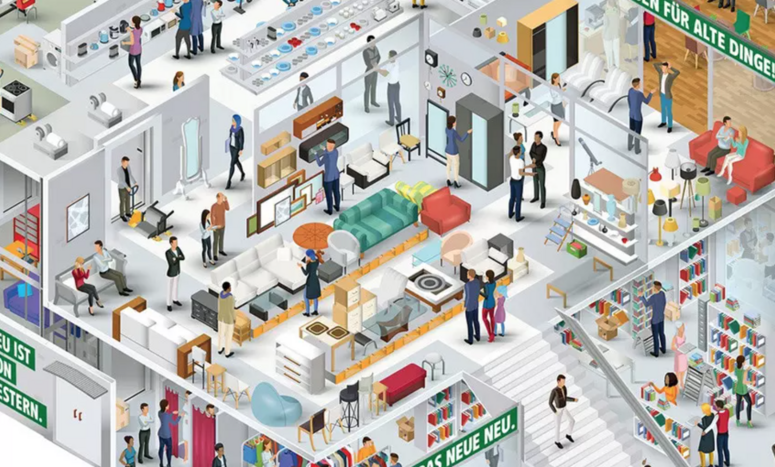
From the article: This department store in Berlin sells only recycled and second-hand goods. World Economic Forum. 30 September 2020. Products at the store include recycled furniture and refurbished electrical appliances. Image credit: City of Berlin/SenUVK
Sharing, re-using and recycling
A real-world example of how Zero Waste Policy can push novel new business models. Designers can not only create designs for new products but can use their capacity to generate desirable products and services into implementing new models of consumption.
SUSTAINABLE FASHION FUTURES
Terminology explained
• Snowdon, Heather. Your A-Z Guide to “Sustainable Fashion”. High Snobiety. April 2021.
“There is no such thing as sustainable fashion”, the authors of this guide remind us. But how do we negotiate the new vocabulary emerging from fashion brands claiming a position somewhere along the sustainability spectrum? What do “carbon neutral” or “upcycled fashion” mean exactly? Is “eco-fashion” really sustainable? How easy is it to vet “ethical fashion” and don't you get the feeling that “regenerative” is the new fashion buzzword?
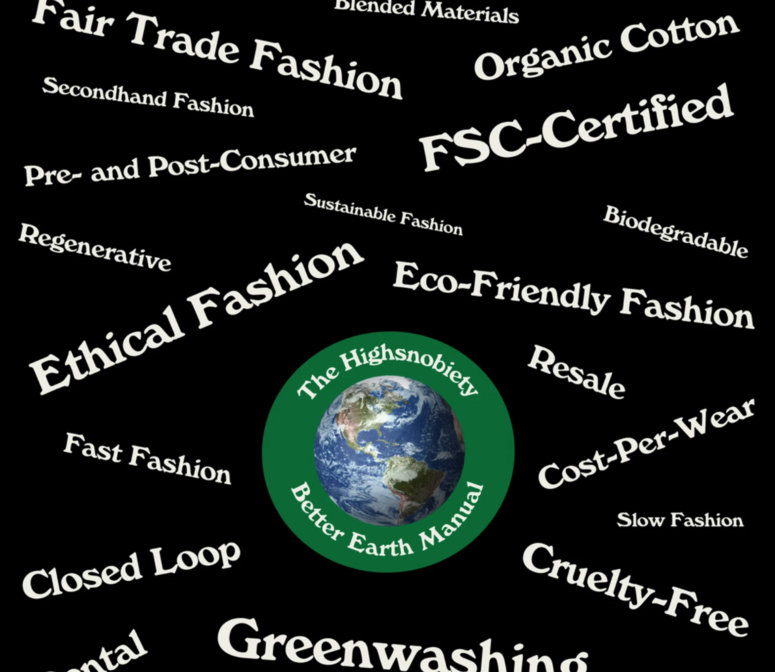
From the article: Your A-Z Guide to “Sustainable Fashion”. High Snobiety. April 2021.
Informative and investigative, this resource gleans from sources such as the New Standard Institute and Future Dust to provide a set of resources about conscious consumption and the pioneers who are making change in the fashion industry. Providing definitions for the new language around sustainability and fashion, this guide addresses the terms, buzzwords and provides critique for each to help designers and consumers navigate the evolving fashion world.
World Economic Forum
• Redesigning Fashion for a Sustainable Future. World Economic Forum (Davos 2020) (Youtube).
The panel discussion, ‘Redesigning Fashion for a Sustainable Future’, presented at the World Economic Forum Annual Meeting in Davos 2020, provided speakers with the space to discuss the latest innovations in textile design, manufacturing and policy. Speakers Brune Poirson, Andrew Moose, Anderson Tanoto, Miroslava Duma, William McDonough and Holly Syrett shared their expertise in the field of textile production, whether from a policy standpoint or manufacturing one—mentioning new scientific data used to guide innovation, the cultural and societal impact that textile and materials have on the built environment, and how policy on textile and garment manufacturing are crucial not only industry-wide, but world-wide.
London College of Fashion
This video gives us a brief look at the science and technology working towards sustainable development at the London College of Fashion, explaining that fashion design is not only a creative field, but one that holds economical, environmental, material and political weight. Through collaboration, fashion has the power to alter people’s lives, improve well-being, while also being ecologically thoughtful. As the challenges faced in fashion are, at times, similar to those faced in other fields—such as the hard sciences—working with specialists in various scientific disciplines allows for innovation and future-proofing of the industry. Proving that fashion does not work in a vacuum, but is actually in constant conversation with various other disciplines allowing it to forever adapt and evolve.
BUSINESS AS USUAL
• Thorbeck, John S. Who Pays for Sustainability? The Business of Fashion
Some industry players continue to hold on to the idea that the sustainability question can be addressed within the current corporate model. In this Op-Ed, John S. Thornbeck, former CEO of GH Bass & Co (PVH), and Rockport (Adidas), and senior executive for Timberland Co and Nike, propose that the sustainability question in corporate fashion can be addressed through careful management of the value chain—specifically, through a sharing of risk throughout the supply chain. What this opinion belies, however, is one of sustainability's greatest challenges: the capacity industry has to convince itself that continued growth is possible and that an 'acceptable' level of sustainability can be achieved without sacrificing consumption.
POLICY INITIATIVES
European Green Deal
The European Commission's 'Green Deal' will start to impact legal frameworks, including initiatives that will directly affect design. With the example of consumer electronics, new legislation is already being put in place that forces manufacturers to report on the repair-ability of their products, including how easily a device can be disassembled and the availability of repair manuals and spare parts. It is widely expected that this new legal framework will push manufacturers to improve their ratings by making the designs of their products more 'repair-able'.
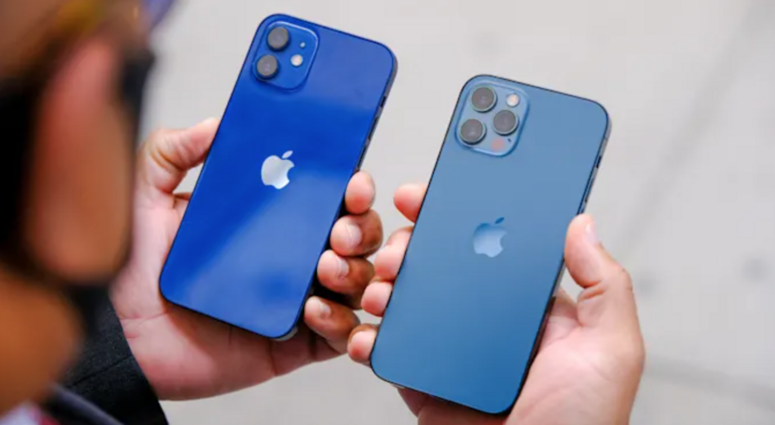
From the article: Apple now shows device repairability scores in France: The iPhone maker is complying with a new anti-waste law. Engaget. 26 February 2021.
Repairability
• Beres, Damon. Your Smartphone Should Be Built to Last. New York Times. 25 April 2021.
On the same note, the scrutiny of the shelf-life of gadgets is now in effect in France. Here are two looks at how the new French legislation on repairability—the “indice de réparabilité” or repairability score—and how it will impact the market for electronics, specifically Apple. Starting in January 2022, this colour-coded anti-waste law rates products according to their sustainability as part of a system “designed to keep shoppers abreast of the lifespan of their electronics to encourage them to choose longer-lasting items.” With 77% of those surveyed saying they would rather repair than replace, and fines for non-compliance expected to be introduced as part of the law, the looming threat of E-waste (which could grow to 52 million tonnes by the end of 2021) proposes a regenerative solution through ‘repairability reform’. Will such movements slow down the release of toxic metals (like arsenic which is issued from smartphones) from landing in dumpsites?
LEXICON
CIRCULAR ECONOMY An economic system based on reducing or eliminating the waste and pollution produced by production by reducing the need for production (through things like sharing, re-use and repair) and optimising a closed loop in the production process (optimising use of material, re-introducing recycled materials). The aim is to thus decouple economic growth from resource consumption and environmental decline.
WICKED PROBLEM A class of social system problems which are ill-formulated, where the information is confusing, where there are many clients and decision makers with conflicting values, and where the ramifications in the whole system are thoroughly confusing (Rittel, 1973)
REPAIRABILITY The facility with which a manufactured object — often an electronic device — can be repaired rather than replaced. European legislation introduced under the 'European New Deal' is putting in place a framework for a 'repairability score' to make this more visible to the consumer.
GREENWASHING An adaptation of the term ‘whitewashing’ this expression refers to false, misleading or exaggerated information concerning environmental impact, generally of a business or product. A deceitful practice, generally adopted by advertising or marketing departments, to benefit from consumer desire to support the environment, without actually benefitting the environment.
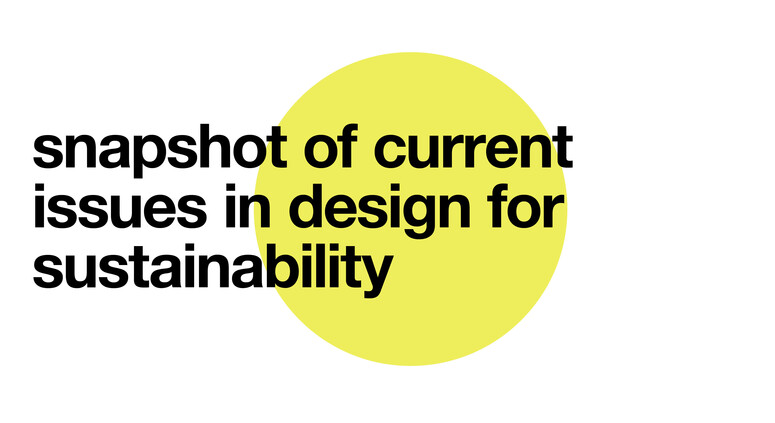
relatedarticles

ICoD exclusive interview with kyle rath on design and AI

robert l. peters: guiding the future of design

ICoD interviews elizabeth (dori) tunstall on decolonising design

it may look good on instagram but you want to enjoy living in it
